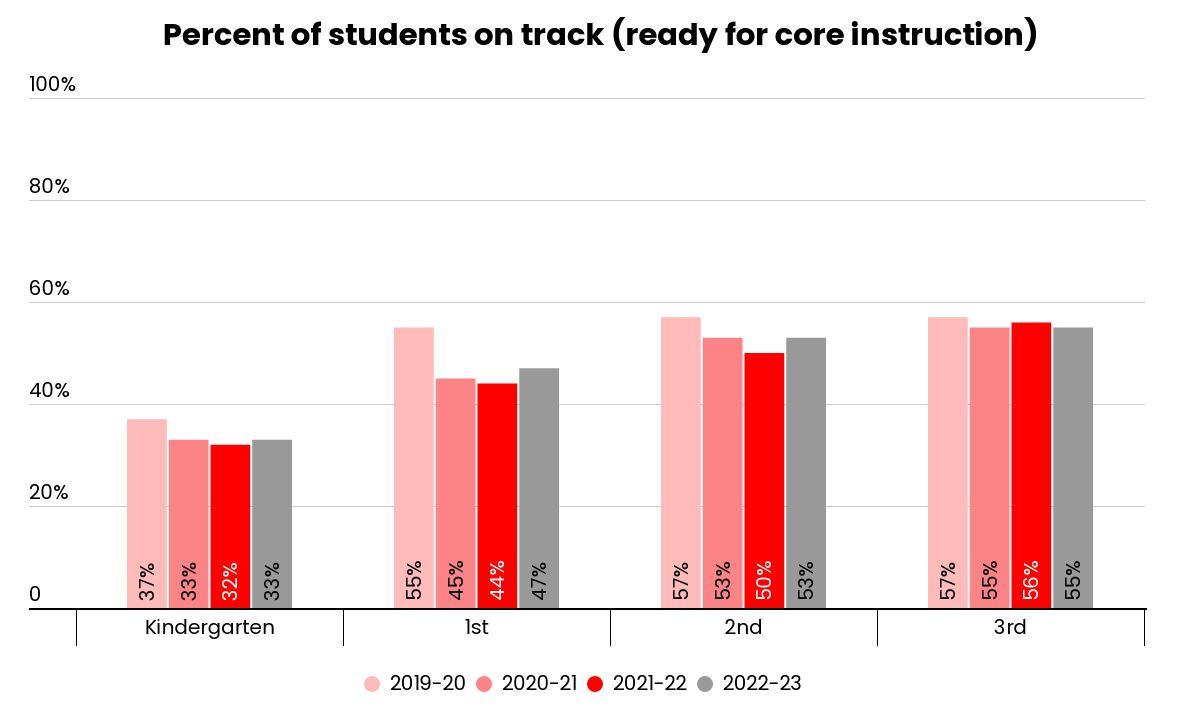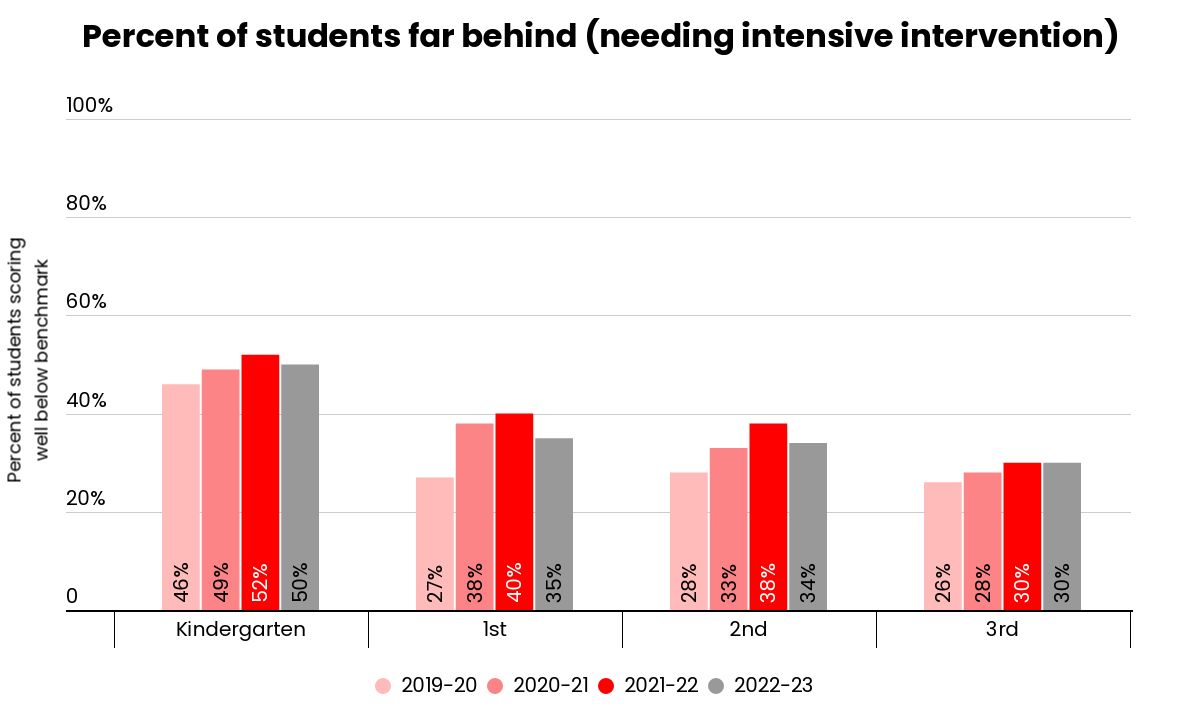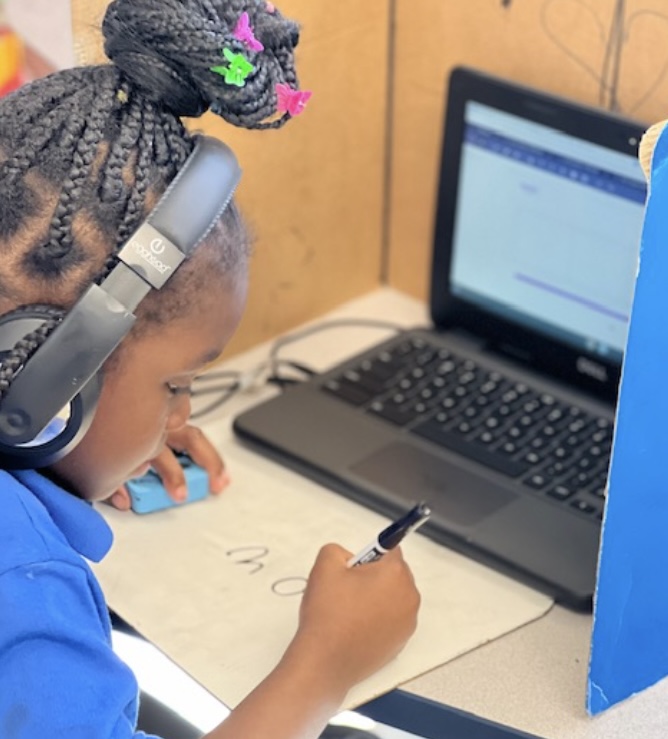Exclusive Literacy Data: Small Gains Since Last Fall, But No Reading Rebound
At least a third of K-3 students still need ‘intensive’ extra help, and almost 50% of 3rd graders are off-track this fall, Amplify found

Get stories like this delivered straight to your inbox. Sign up for The 74 Newsletter
Students who learned to read during the pandemic are still performing below those who were in early grades before schools closed — in some cases, well below, new data shows.
Fifty-three percent of second graders are on track in reading this fall, compared to 57% in 2019, according to Amplify, a curriculum provider. In first grade, the decline is greater — 8 percentage points.
There’s also some good news: The percentage of students in kindergarten through second grade reading on grade level is slightly higher than last year. But the rate in third grade dropped. And almost a third of those students need “intensive intervention,” like small group instruction or a double block of time on literacy during the school day, according to the results.

Susan Lambert, Amplify’s chief academic officer for elementary humanities, said she’s most concerned about students who aren’t getting strong reading instruction “to begin with” and then “aren’t receiving intervention either.”
She said teachers should be able to tell parents if their child is at risk and if they’re “slightly below grade level or really below grade level.” Then, she added, they should point to what students haven’t mastered and how they plan to work on those skills.
The results from 300,000 students in 40 states offer the first national snapshot of students’ reading performance this fall and reinforce takeaways from other recent tests. Students in some grade levels are approaching pre-pandemic levels. But as many researchers have predicted, it could take years before academic performance fully rebounds. Amplify will assess reading two more times this school year, offering educators and researchers a chance to see if students make strides by spring. But that depends on districts’ ability to overcome some of the major dilemmas they faced last year, including high absenteeism and teacher shortages.
“I actually expect we’re going to see better progress this year,” Lambert said. She noted that last year, students needed to readjust to classroom routines and teachers faced more social-emotional and behavior issues than they had in the past.
Those were the conditions in which fourth graders took the National Assessment of Educational Progress, due for release Monday. The results are expected to bring more crushing news about students’ reading skills. Those students would have been second graders when schools shut down, in the process of moving from an emphasis on word recognition to reading more challenging fiction and nonfiction. But many spent most or all of third grade learning remotely.
“Making that academic shift is big for them,” Lambert said.
To measure early literacy skills, like letter sounds, sight words and fluency, teachers used the Dynamic Indicators of Basic Literacy Skills, or DIBELS. While the test was administered virtually during school closures, it was still conducted as teachers observed students’ reading, which increases the reliability of the results, said Paul Gazzerro, Amplify’s director of data analysis.
The sample of students from 1,400 schools is not a “niche” data set, and the results represent 2 million students nationally, he said. “I think it actually speaks somewhat to what we see more broadly.”
But some students aren’t just off-track, he said, they’re multiple grade levels behind.
That’s what Jessica Sliwerski has seen at schools using the Ignite Reading tutoring program she founded a year ago. Third graders were reading at kindergarten and first grade levels.
“They have major decoding gaps,” she said. “I’d bet heavily that many third graders graduated into fourth grade this year and are still not able to read.”

By fourth grade, the curriculum requires students to do much more than sound out words.
“It’s noticing and wondering and context-building,” said Michael Burks, principal of Kipp Bridge Academy, a charter school in Oakland, California. The school was a pilot site for Ignite, which this year expanded to 1,100 students in six states.
Kipp Bridge is using the program in first, second and fourth grade to help students make up skills missed during remote learning. “We had some kids who were on a computer in the back of the car while mom and dad were doing DoorDash deliveries,” Burks said.
But he’s pleased with progress so far. All fourth graders who used Ignite Reading last year entered this fall on grade level, he said. And between 2021 and 2022, there was a 4% increase in students mastering English language arts skills on the state test.
“We are trending in the right direction,” he said.
The downside is that because of the program’s cost, only about 20 students in the three grade levels are receiving the extra support. It costs $2,500 per seat for a year, meaning that the same student might not use the program the whole time. Ignite’s tutors work with students over Zoom, usually during the school day.
“It’s a little bit of a triage situation,” Burks said. His goal is to eventually target the program to first graders to give them a solid foundation.
Similarly, the pandemic has accelerated a movement among states and districts toward phonics-based curricula and phasing out so-called “balanced” approaches, which focus on access to books and using pictures or other cues to read unfamiliar words.
According to ExcelinEd, an education policy think tank, 12 states have comprehensive early literacy policies that include “science of reading” training for teachers, screening for students with reading disabilities and extra help for those who are struggling. Five of those states — Arizona, Ohio, Michigan, North Carolina and Tennessee — added features last year as the impact of remote learning became clear.
Four states implemented policies after the release of 2019 NAEP results, which experts said already pointed to a reading crisis. Lambert said in addition to adopting high-quality materials, district leaders need to ensure school schedules allow for extra time on literacy instruction and target individualized or small group help to schools with the highest population of at-risk students.
Next week’s results will “probably not [be] good news, but it’s not that much worse than it’s always been,” she said. “We’ve had a struggle for a long time and I hope that people at all levels understand that it’s a long game.”
Get stories like these delivered straight to your inbox. Sign up for The 74 Newsletter

;)
